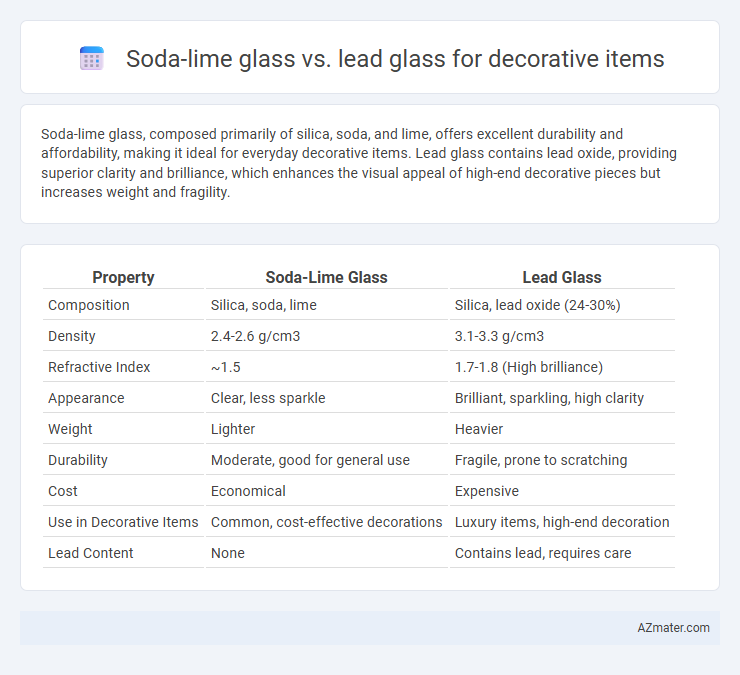Soda-lime glass, composed primarily of silica, soda, and lime, offers excellent durability and affordability, making it ideal for everyday decorative items. Lead glass contains lead oxide, providing superior clarity and brilliance, which enhances the visual appeal of high-end decorative pieces but increases weight and fragility.
Table of Comparison
| Property | Soda-Lime Glass | Lead Glass |
|---|---|---|
| Composition | Silica, soda, lime | Silica, lead oxide (24-30%) |
| Density | 2.4-2.6 g/cm3 | 3.1-3.3 g/cm3 |
| Refractive Index | ~1.5 | 1.7-1.8 (High brilliance) |
| Appearance | Clear, less sparkle | Brilliant, sparkling, high clarity |
| Weight | Lighter | Heavier |
| Durability | Moderate, good for general use | Fragile, prone to scratching |
| Cost | Economical | Expensive |
| Use in Decorative Items | Common, cost-effective decorations | Luxury items, high-end decoration |
| Lead Content | None | Contains lead, requires care |
Introduction to Decorative Glass: Soda-Lime vs Lead Glass
Soda-lime glass is the most common decorative glass, favored for its affordability, ease of production, and good durability. Lead glass, or crystal, contains lead oxide, enhancing its weight, brilliance, and clarity, making it ideal for luxury decorative items. The choice between soda-lime and lead glass depends on the desired aesthetic quality, cost, and application in decorative products.
Chemical Composition Differences
Soda-lime glass contains mainly silicon dioxide (SiO2), sodium oxide (Na2O), and calcium oxide (CaO), providing durability and cost-effectiveness for decorative items. Lead glass incorporates a high percentage of lead oxide (PbO), which increases the refractive index and enhances brilliance and weight, making it ideal for luxury decorations. The presence of lead also lowers the melting point, allowing for finer detailed designs compared to soda-lime glass.
Visual Appearance and Clarity
Soda-lime glass offers a clear and durable surface with a slightly greenish tint, making it suitable for everyday decorative items but less brilliant in light refraction. Lead glass, commonly known as crystal, contains lead oxide which significantly enhances its clarity and brilliance, producing superior sparkle and a more vibrant visual appearance. The higher refractive index of lead glass makes it the preferred choice for premium decorative pieces requiring exceptional clarity and light dispersion.
Weight and Handling Characteristics
Soda-lime glass is lighter and easier to handle, making it ideal for large decorative items requiring frequent movement or installation. Lead glass, also known as crystal, is denser and heavier, providing a premium feel and enhanced brilliance but demands careful handling due to its weight. The higher density of lead glass also results in increased fragility, which affects long-term durability for decorative displays.
Durability and Resistance to Scratches
Soda-lime glass offers moderate durability and is prone to scratching due to its softer surface, making it less ideal for high-wear decorative items. Lead glass, also known as crystal, features enhanced durability and greater scratch resistance thanks to its higher density and lead oxide content. This makes lead glass preferable for decorative items requiring long-lasting clarity and resilience against surface damage.
Safety Concerns and Toxicity
Soda-lime glass, commonly used in decorative items, is non-toxic and safe for general handling and display, posing minimal health risks. Lead glass, while prized for its brilliance and clarity, contains significant amounts of lead, which can leach out and pose toxicity hazards, especially if damaged or improperly handled. Choosing soda-lime glass reduces safety concerns related to lead exposure, making it a safer option for homes with children or frequent human contact.
Ease of Shaping and Crafting Intricate Designs
Soda-lime glass offers easier shaping due to its lower melting point and greater malleability, making it ideal for crafting intricate designs in decorative items. Lead glass, while heavier and more refractive, requires higher temperatures and careful handling to shape, which can limit detailed molding capabilities. Artists often prefer soda-lime glass for complex patterns, while lead glass is favored for its brilliance in simpler forms.
Suitability for Engraving and Cutting
Soda-lime glass offers moderate suitability for engraving and cutting due to its balanced hardness and cost-effectiveness, making it ideal for decorative items requiring simple, shallow designs. Lead glass, also known as crystal glass, provides superior clarity and brilliance, enhancing intricate engraving details and allowing deeper, more precise cuts because of its softer composition and higher density. For decorative items demanding fine craftsmanship and high-quality visual appeal, lead glass is preferred despite being heavier and more expensive than soda-lime glass.
Cost Comparison for Decorative Projects
Soda-lime glass is significantly more cost-effective than lead glass for decorative projects, making it the preferred choice for budget-conscious designs. Lead glass offers superior brilliance and weight, but its higher raw material and production costs result in a price premium often double that of soda-lime glass. For large-scale decorative installations, using soda-lime glass maximizes cost-efficiency without sacrificing basic aesthetic qualities.
Best Applications: When to Choose Soda-Lime or Lead Glass
Soda-lime glass is ideal for everyday decorative items due to its affordability, durability, and ease of shaping, making it suitable for vases, light fixtures, and picture frames. Lead glass, also known as crystal, offers superior brilliance and weight, making it the preferred choice for luxury decorative pieces like chandeliers, fine glassware, and ornamental bowls that require enhanced clarity and sparkle. Opt for soda-lime glass when cost-effectiveness and practicality are priorities, while lead glass is best reserved for premium items that emphasize aesthetic appeal and elegance.

Infographic: Soda-lime glass vs Lead glass for Decorative item
 azmater.com
azmater.com